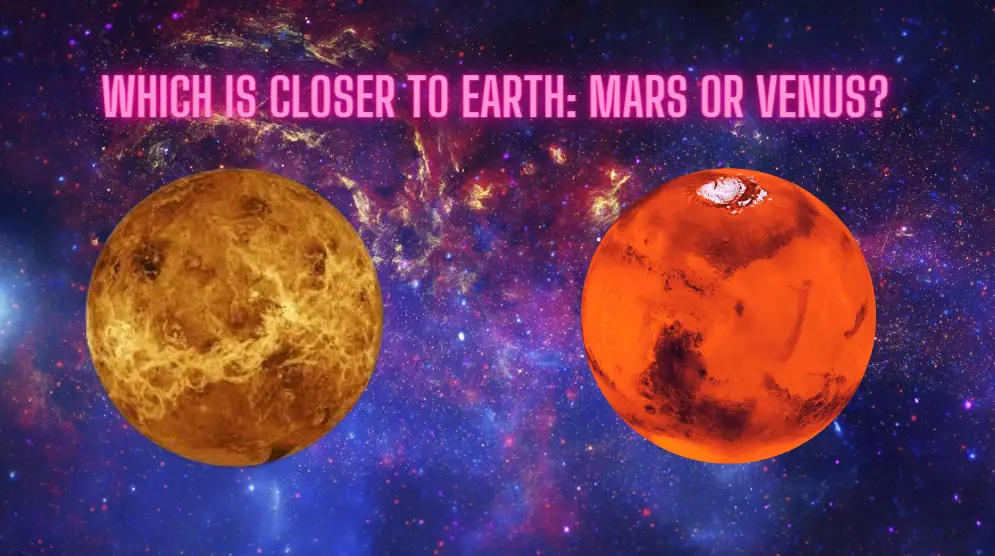The tremendous expanse of our solar system has, for a very long time, focused attention and interest on Earth as a prime location for discovery and investigation. As we travel further out into space, the question of which of our neighboring planets is nearest to our own home eventually emerges. Mars and Venus, which are frequently referred to as Earth’s cosmic siblings, captivate people’s imaginations due to the fact that each planet possesses its own set of distinctive qualities and has the potential to be explored.
But in terms of physical distance, which planet is actually closer to the Earth than the others?
In order to determine which planet is closest to the sun, we need to take into account not only the average distances that separate each planet from the star, but also the orbits that each planet follows. It is helpful to keep in mind that the typical distance between Earth and the Sun is around 93 million miles (or 150 million kilometers), which can be used as a point of reference when making comparisons.
Mars, also known as the “Red Planet,” is the fourth planet out from the Sun in the planetary system. It is around 142 million miles (or 228 million kilometers) away from the Sun on average. When Mars and Earth are aligned so that they are facing the same direction relative to the Sun, the distance between them can be as close as 35 million miles (or 56 million kilometers). The occurrence of this phenomena, which is referred to as “opposition,” takes place about once every 26 months. When Mars is in opposition, it is in its most accessible position in the night sky, where it can be seen as a brilliant, ruddy star-like object.
Venus, on the other hand, is the second planet from the Sun and is frequently referred to as the “sister planet” of Earth due to the fact that its size and composition are very similar to those of Earth. The average distance between Venus and the Sun is approximately 67 million miles (or 108 million kilometers). On the other hand, when Venus and Earth are aligned so that they are facing the same side of the sun, the distance between them can be as close as 24 million miles (or 38 million kilometers). During this near proximity, which is known as a “inferior conjunction,” which occurs approximately every 19 months, Venus is not visible to the human eye because it is positioned between the Earth and the Sun.
When average distances are taken into account, it is obvious that Venus is far closer to Earth than Mars is. On the other hand, as a consequence of the mechanics of the orbits of the inner planets, Mars is able to approach the Earth at a distance that is considerably closer during opposition than Venus is able to achieve at inferior conjunction. Because of its near to Earth, Mars is frequently the objective of a large number of space missions; as a result, these missions typically have shorter journey periods and require less fuel.
Even though Venus is on average closer to Earth than any other planet, it nonetheless poses a number of difficulties for investigation. A runaway greenhouse effect has been generated on Venus as a result of the planet’s excessive greenhouse effect, which has led to a surface temperature that is higher than 430 degrees Celsius (almost 800 degrees Fahrenheit). Because of the planet’s thick atmosphere and corrosive clouds of sulfuric acid, any hypothetical future missions that take place there will face challenging conditions. In spite of these obstacles, scientists continue to be fascinated by Venus, and they employ spacecraft in their investigations of the planet’s atmosphere and the geological features it contains.
Mars, on the other hand, has been getting a lot of attention lately, both from space organizations and scientists in general. Mars is an alternative that is more feasible for human exploration and settlement due to its lack of an atmosphere and the possibility of having once supported ancient life. A number of different missions have been dispatched to the planet Mars in order to investigate its geology, look for traces of extinct life, and prepare for future manned expeditions.
When the average distances between the two planets are taken into account, we find that Venus is closer to Earth than Mars. Mars, on the other hand, can come incredibly near to Earth during opposition due to the nature of their orbits, which makes it an appealing target for research. Each planet presents its own distinct set of possibilities for scientific research and exploration, and future expeditions to Mars and Venus will continue to broaden our understanding of the planets in our neighborhood and the likelihood of finding life elsewhere in the cosmos.
![]()
